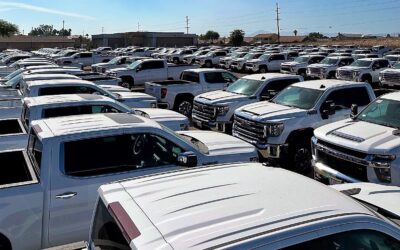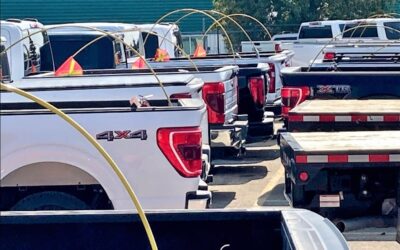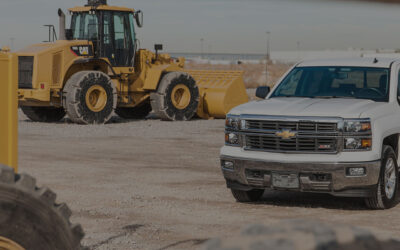Fleet Maintenance: Everything You Need to Know
Although we may call this era the “digital age,” there is still a very real demand for physical commodities. Businesses of all kinds and sizes regularly transport materials, goods, and people, meeting customer needs wherever they occur. As such, everything from small local delivery companies to multinational corporations depends heavily on their vehicles. And when those vehicles suffer unexpected breakdowns, it can result in major disruptions to company fleet operations.
Simply put, if your vehicles aren’t operating at top performance then they are hurting your business. To ensure that your fleet is fully operational when and where you need it, make regular fleet maintenance a priority.
What Is Fleet Maintenance?
Fleet maintenance is a systematic approach to ensuring that your company’s vehicles remain in good working condition so that they can be operated safely, reliably, and efficiently. Fleet maintenance involves several key elements, including routine inspections, servicing, repairs, and preventive measures to minimize unexpected breakdowns. The ultimate goal of fleet maintenance is to reduce operating costs, improve vehicle inspection outcomes, and enhance overall fleet performance.
Preventative fleet maintenance programs are integral to effective fleet operations and fleet risk management.
Benefits of Fleet Maintenance
Fleet maintenance keeps your essential vehicles on the road, providing your business with several important advantages:
- Lower repairs costs
maintenance and preventive measures help you avoid the high-cost repairs that come from unexpected breakdowns. And because it’s almost always more cost-effective to prevent a problem than to try to fix one, this has the potential to save you a significant amount of money in the long run.
- Reduced operational costs
Well-maintained vehicles exhibit better fuel efficiency and optimized performance, leading to reduced fuel consumption, lower maintenance expenses, and extended vehicle lifespan.
- Enhanced compliance
Maintaining a documented fleet maintenance program helps ensure compliance with regulatory standards, enabling vehicles to pass inspections and meet safety, emissions, and licensing requirements. If you’re interested in avoiding penalties and enhancing your industry reputation, then proactive fleet maintenance is a must.
- Improved reliability
The right approach to fleet maintenance and repair enhances vehicle reliability, minimizing unplanned downtime and ensuring consistent availability for time-sensitive deliveries or services.
- Increased safety
Routine maintenance activities identify and address potential safety hazards (such as worn-out tires or faulty brakes), reducing the risk of accidents. Protect the safety of your drivers, your valuable assets, and others on the road while also safeguarding your company’s reputation. Regular fleet maintenance makes it all possible.
How to Maintain a Fleet
Maintaining a fleet involves implementing an approach that accounts for preventive maintenance and corrective maintenance:
Preventive Maintenance
Preventive maintenance refers to scheduled maintenance tasks designed to maintain equipment or vehicles in order to prevent potential failures, maximize performance, and extend their operational lifespan. Preventive maintenance occurs so that smaller issues that might otherwise go unnoticed can be identified and resolved before they evolve into larger problems.
Examples of preventive fleet maintenance include:
- Fluid checks and replacements
Monitoring and topping up essential fluids such as oil, coolant, brake fluid, and windshield washer fluid.
- Tire maintenance
Rotating and balancing tires, checking tread wear, and ensuring proper inflation levels for improved fuel efficiency and tire longevity.
- Filter replacements
Regularly changing air filters, oil filters, and fuel filters to maintain engine performance and prevent contamination.
- Battery maintenance
Inspecting and cleaning battery terminals, ensuring proper connections and charging to avoid unexpected battery failures.
- Belt and hose inspections
Checking and replacing worn-out or damaged belts and hoses to prevent breakdowns and potential engine damage.
- Brake system maintenance
Inspecting brake pads, rotors, and calipers, and addressing any issues promptly to ensure safe braking performance.
- Electrical system checks
Verifying the functionality of lights, signals, and other electrical components, replacing faulty bulbs or wiring as needed.
Corrective Maintenance
Corrective maintenance involves addressing and resolving unexpected equipment or vehicle failures or malfunctions, aiming to restore their functionality and minimize downtime.
Examples of corrective maintenance include:
- Fixing mechanical faults
Resolving problems related to steering, suspension, exhaust systems, or any other components that affect vehicle performance and safety.
- Replacing burnt-out or broken headlights
Removing non-operable headlights and replacing them with new ones.
- Replacing worn-out parts
Upgrading or replacing components such as brake pads, spark plugs, windshield wipers, or timing belts that have reached the end of their usable life.
- Fixing flat tires
Patching or replacing flat tires and ensuring that the wheels are correctly aligned after the new tires have been installed.
- Diagnostic testing and troubleshooting
Utilizing advanced diagnostic tools to identify complex mechanical or electrical issues.
- Emergency repairs
Handling unexpected breakdowns or malfunctions promptly to minimize downtime and ensure driver safety.
Roles within Fleet Maintenance
Fleet maintenance depends on the coordinated efforts of professionals at multiple levels throughout an organization. The three most relevant roles in fleet maintenance are:
- Fleet managers
Fleet managers oversee the overall maintenance of the vehicle fleet. Their responsibilities include developing and implementing fleet maintenance policies and procedures, creating inspection and maintenance schedules, monitoring vehicle performance and maintenance records, tracking costs, providing training, managing parts inventories, ensuring regulatory compliance, and coordinating between stakeholders. - Mechanics
Fleet mechanics are responsible for diagnosing and addressing mechanical issues in fleet vehicles. They are most responsible for performing scheduled maintenance services, using diagnostic equipment to troubleshoot complex issues, conducting safety and compliance inspections, documenting maintenance activities, and handling emergency repairs. - Drivers
As the front lines of fleet maintenance, drivers are also often the first layer of response in identifying potential issues with the vehicles. In terms of fleet maintenance, drivers are generally expected to conduct pre-trip inspections to ensure that the vehicle is in good working condition, adhere to maintenance schedules, keep accurate mileage and fuel consumption records, and follow safe driving practices to minimize wear and tear on the vehicles.
Fleet Maintenance with Summit Fleet
There will always be a need for physical commodities and the means to transport them. Unfortunately, maintaining a fleet of vehicles can be a demanding and time-consuming task, requiring expertise, resources, and constant attention to ensure optimal performance and minimal risk. If the prospect of ongoing preventive and corrective maintenance seems daunting, consider working with a trusted fleet rental service, such as Summit Fleet.
Summit Fleet handles all fleet maintenance and repair tasks, ensuring that the vehicles that drive your business are always operating at top capacity. Streamline your operations, minimize costs, and enjoy the convenience of a well-maintained fleet that supports your business goals.
Click here to learn more about the benefits of fleet rental solutions. Work with a partner who has the resources to keep your fleet running for years to come — contact Summit Fleet today!






